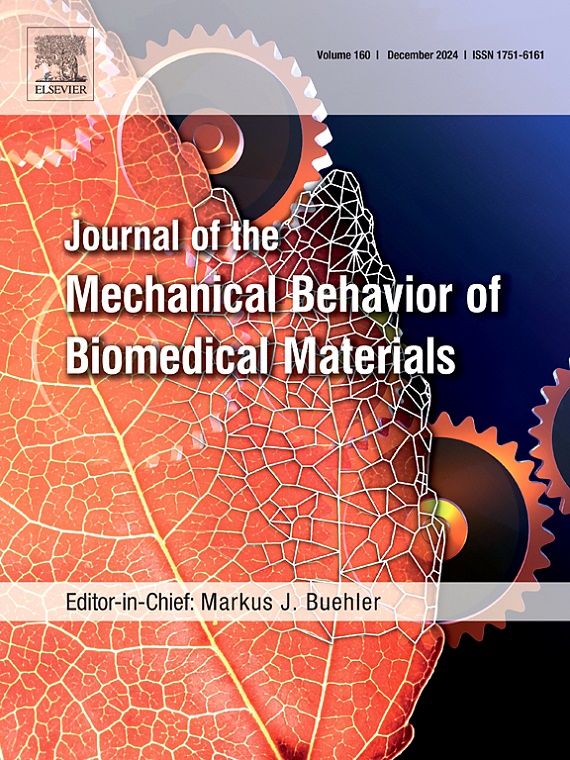Impact of polishing, glazing and firing, restoration thickness, point of loading and aging on the edge chipping resistance of lithium silicate ceramics
IF 3.5
2区 医学
Q2 ENGINEERING, BIOMEDICAL
Journal of the Mechanical Behavior of Biomedical Materials
Pub Date : 2025-06-20
DOI:10.1016/j.jmbbm.2025.107106
引用次数: 0
Abstract
Objectives
To investigate the edge chipping resistance (ECR) of four lithium silicate ceramics at different thicknesses and points of loading after various surface treatment, firing and aging protocols.
Methods
288 rectangular specimens were cut from CAD/CAM ceramics (lithium-di-silicate: Amber Mill, Amber Mill Direct, IPS e.max CAD; lithium-alumino-silicate: CEREC Tessera) in three thicknesses (1.5 mm, 2 mm, 3 mm) and underwent different surface treatments (polishing, glazing, no surface treatment) and/or firing protocols (high translucency, medium opacity). Specimens were bonded to 4 mm thick dentine analogues and loaded 0.25 mm or 0.30 mm from the edge using a Vickers diamond indenter. ECR was determined initially, after thermocycling (5/55 °C, 10,000 cycles) and after hydrothermal aging (134 °C, 0.2 MPa, 120min). Force when chipping occurred was recorded and ECR calculated. Data were analyzed with Kolmogorov-Smirnov, Kruskal-Wallis, Mann-Whitney U, Friedmann and Wilcoxon tests (p < 0.05).
Results
For 7/18 groups, glazed and medium opacity fired Amber Mill showed higher ECR than all other groups. In comparison with polishing or exclusive firing, a surface treatment with glazing led to the highest ECR. The influence of specimen thickness and point of loading was negligible. While aging reduced the ECR in 50 % of the glazed groups, the ECR of those groups remained among the highest.
Significance
With the majority of groups showing no impact of the specimen thickness, a reduced restoration thickness of 1.5 mm seems to present limited disadvantages and should thus be considered for minimal invasive treatments. With regards to ECR, glazing can be recommended as the preferred surface treatment method for CAD/CAM lithium silicate ceramics.

抛光、上釉和烧成、修复厚度、加载点和时效对硅酸锂陶瓷抗边缘剥落的影响
目的研究四种硅酸锂陶瓷在不同的表面处理、烧制和时效方式下,在不同厚度和加载点下的抗边缘剥落性能。方法从CAD/CAM陶瓷(二硅酸锂:Amber Mill, Amber Mill Direct, IPS e.max CAD;锂铝硅酸盐:CEREC Tessera)三种厚度(1.5 mm, 2mm, 3mm),并进行了不同的表面处理(抛光,上光,无表面处理)和/或烧制方案(高半透明,中等不透明度)。将样品粘接到4毫米厚的牙本质类似物上,并使用维氏金刚石压头从边缘加载0.25毫米或0.30毫米。测定初始ECR、热循环(5/55°C, 10000次循环)和水热老化(134°C, 0.2 MPa, 120min)后的ECR。记录切屑发生时的力并计算ECR。数据分析采用Kolmogorov-Smirnov、Kruskal-Wallis、Mann-Whitney U、Friedmann和Wilcoxon检验(p <;0.05)。结果在7/18组中,釉面和中不透明度烧制琥珀磨的ECR高于其他各组。与抛光或单独烧制相比,表面上光处理的ECR最高。试件厚度和加载点的影响可以忽略不计。虽然老化降低了50%的釉面组的ECR,但这些组的ECR仍然是最高的。由于大多数组没有显示对标本厚度的影响,减少1.5 mm的修复厚度似乎缺点有限,因此应该考虑进行微创治疗。对于ECR,上釉可以推荐作为CAD/CAM硅酸锂陶瓷的首选表面处理方法。
本文章由计算机程序翻译,如有差异,请以英文原文为准。
求助全文
约1分钟内获得全文
求助全文
来源期刊

Journal of the Mechanical Behavior of Biomedical Materials
工程技术-材料科学:生物材料
CiteScore
7.20
自引率
7.70%
发文量
505
审稿时长
46 days
期刊介绍:
The Journal of the Mechanical Behavior of Biomedical Materials is concerned with the mechanical deformation, damage and failure under applied forces, of biological material (at the tissue, cellular and molecular levels) and of biomaterials, i.e. those materials which are designed to mimic or replace biological materials.
The primary focus of the journal is the synthesis of materials science, biology, and medical and dental science. Reports of fundamental scientific investigations are welcome, as are articles concerned with the practical application of materials in medical devices. Both experimental and theoretical work is of interest; theoretical papers will normally include comparison of predictions with experimental data, though we recognize that this may not always be appropriate. The journal also publishes technical notes concerned with emerging experimental or theoretical techniques, letters to the editor and, by invitation, review articles and papers describing existing techniques for the benefit of an interdisciplinary readership.
 求助内容:
求助内容: 应助结果提醒方式:
应助结果提醒方式:


